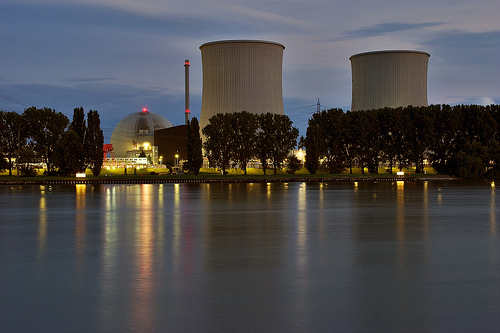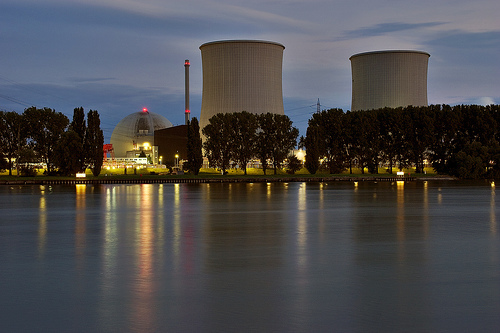 Germany plans to phase out all of its entire nuclear power within 11 years.Photo: Andy RudorferCross-posted from RenewableEnergyWorld.com. This post was coauthored by Wilson Rickerson, CEO of Meister Consultants Group, who leads the company’s international energy and climate work.
Germany plans to phase out all of its entire nuclear power within 11 years.Photo: Andy RudorferCross-posted from RenewableEnergyWorld.com. This post was coauthored by Wilson Rickerson, CEO of Meister Consultants Group, who leads the company’s international energy and climate work.
During the last several years, there has been talk of a global “renaissance of nuclear energy.” That was yesterday. Today, the tragic disaster in Fukushima, Japan, has raised worrying questions about the safety standards of existing nuclear power plants.
Countries around the world have prompted safety reviews of active reactors. In the U.S., the Nuclear Regulatory Commission will publish a review of the 104 active reactors within three months. China has meanwhile suspended new plant approvals and Switzerland has shut down its plans for nuclear expansion.
But safety issues are not the only concern for nuclear power these days. Rising costs and perceived financial risks are significant barriers to new investments. President Obama supports nuclear power and has included it in his plans to achieve 80 percent clean energy by 2035.
The administration has also requested that Congress triple the Bush-era nuclear loan guarantees to $54.5 billion. But despite this federal support, the financial outlook is grim and several projects in the U.S. are delayed or have been cancelled. Analyses [PDF] suggest that even before the Fukushima crisis, nuclear energy was not competitive in free market economies without significant government support.
Transition or transformation? Benchmarking against Germany
Countries around the world are in need of reliable and clean energy. Climate change will require a transition towards a low carbon economy within the next decades. In the wake of Fukushima, the key question is: “If not nuclear, what’s next?” As policymakers and industry stakeholders around the world continue to evaluate the role of nuclear power for energy transition, it will be useful for the U.S. to benchmark its strategies against those of other countries.
Germany, in particular, is pursuing a path forward that represents a significant departure from business-as-usual in the U.S. and other countries. Rather than developing nuclear power, Germany is aggressively pursuing renewable energy in combination with innovative new electricity grid management strategies. Interestingly, Germany used to depend much more on nuclear electricity (~30 percent of national supply in 1999) than the U.S. currently does (~20 percent).
The scale of change that will be required for Germany to meet its renewable energy targets is unprecedented. In Sept. 2010, the conservative government under Chancellor Angela Merkel released its “Energy Concept,” which outlines the government’s plan to reduce carbon emissions 40 percent below 1990 levels by 2020 (and 80 percent by 2050) in part by increasing the national share of renewable electricity to more than 35 percent in 2020 and to 80 percent by 2050. Within four decades, one of the world’s leading economies will be powered almost entirely by wind, solar, biomass, hydro, and geothermal power.
The German government is combining its push for renewables with a rapid retreat from its existing nuclear assets. Following the Fukushima disaster, the German government announced a three-month shutdown of seven of its 17 nuclear power plants and a review of its nuclear strategy. No blackout followed and national energy supply has remained stable.
Nuclear power capacity was replaced by reducing surplus electricity exports, by temporarily importing electricity from neighboring countries, and by using the reserve capacity of traditional backup power plants. Some analysts have argued that a nuclear scale-back in Germany would prevent the country from reaching its long-term climate and energy goals. In reality, Germany is already well on its way to transitioning from nuclear and fossil fuel power to renewable energy.
The old nuclear power plants had been a bottleneck for greater investment. With the planned phaseout of all nuclear power capacity, investors are lining up to put more renewable energy and high-efficiency natural gas plants in place. Overall, CO2 emissions will not rise as the energy sector has to comply with the European Emissions Trading System (ETS) and the associated emissions cap.
Within the next decade: Germany’s nuclear phaseout
There has been strong anti-nuclear sentiment in Germany since the nuclear accident in Chernobyl in 1986. This has been reflected in a series of legislation placing limitations on nuclear build out. In 2002, Germany passed legislation establishing a phaseout of nuclear power by 2022. In 2010, the Merkel government confirmed the phaseout in general, but extended plant lives by an additional 8-12 years.
This extension, which was framed as a necessary “bridge” to a renewable energy future, was unpopular with the public. Soon after the Fukushima crisis, Merkel’s party (the conservative Christian Democratic Union, or CDU) lost a key election in the state of Baden-Württemberg. The historic election was largely seen as a referendum on nuclear power and it handed the governorship of Baden-Württemberg, one of Germany’s largest and most economically powerful states, to the Green Party, following close to six decades of CDU rule.
At the national level, there is now a new consensus across the political parties in Germany that the nuclear phaseout will again be accelerated. The question is not if Germany will phase out nuclear power, but how quickly. Instead of being shut down some time after 2030, current proposals envision full nuclear shut down some time between 2015 and 2025.
Renewable energy in Germany: Implementing rapid transformation
In advance of the phaseout revision, Merkel met with the governors of the 16 German states in April of this year and outlined a plan to accelerate Germany’s transition from fossil fuel and nuclear power to renewable energy. This is a remarkable development because Germany already has one of the fastest growing renewable energy markets in the world.
During the past decade, Germany has fundamentally transformed the way it produces electricity: From 2000 to 2010, Germany increased its share of renewable electricity from 5 percent to 17 percent. The country has consistently met its legislated targets ahead of schedule and appears poised to outdo itself again in the next few years. The previous target of 30 percent renewable electricity by 2020 has recently been updated by Germany’s official “National Renewable Energy Action Plan” [PDF] (NREAP). The NREAP reveals that the country expects to actually generate 38 percent of its electricity from renewables by 2020.
While hydropower, geothermal, and biogas play an important role in the renewable mix, wind and solar power will expand the most rapidly under the German renewable energy strategy. It is projected that wind and solar will supply 18 percent and 7 percent of national electricity by the end of this decade, respectively. Although Germany has received criticism for supporting comparatively high-cost photovoltaic (PV) systems, the government remains committed to growing its PV markets and it seems likely that PV will be competitive with retail electricity within the next two to three years.
Several PV markets in Europe — the Czech Republic, France, and Spain — were recently scaled back following rapid market growth in 2008-2010. Some analysts speculated that Germany would be the next large PV market to be capped. Germany has installed 17,000 megawatts of PV to date which amounts to more than half of the world’s total, including over 7,400 megawatts of new PV capacity in 2010 alone. The official projections are that PV will expand to more than 50,000 megawatts by 2020. This equals the capacity of 70 coal-fired power plants. Given the phaseout of nuclear power, it is likely that this projection could be revised upward as the transition towards a renewable energy based economy accelerates.
Rethinking the way we do business
Most electricity grids have not been built to accommodate the scale of intermittent energy generation (e.g. wind and solar) envisioned in Germany. When pressed about this challenge, a German government official recently responded, “Without a problem there would be no solutions.” Rather than viewing the restructuring of the current grid as an insurmountable obstacle, Germany views the challenge as an opportunity for necessary innovation to support an affordable, clean, and more decentralized energy system in the future. As Germany’s minister of environment recently stated [PDF]:
It is economically nonsensical to pursue two strategies at the same time, for both a centralized and a decentralized energy supply system, since both strategies would involve enormous investment requirements. I am convinced that the investment in renewable energies is the economically more promising project.
The future of the German electricity industry will require a rethinking of the way energy is bought, sold, and transmitted. In developing the “Energy Concept” and in presenting its recent six-point plan for accelerated transition, the Merkel government has identified several key initiatives to reorganize the grid, including:
- Maximizing existing storage options and rolling out innovative new battery technologies.
- Relying increasingly on flexible power plants, such as biomass, biogas, and natural gas, that can more readily balance intermittent wind and solar generation.
- Strengthening and expanding existing electricity grid infrastructure, including the construction of transmission superhighways that can move electricity between the north of the country, where wind is plentiful, and the south, where the solar resource is stronger.
- Widespread introduction of smart meters and smart grid technologies.
- Accelerated energy efficiency deployment.
If centralized nuclear energy and renewable energy are indeed on a collision course, then the German government is working to ensure that renewables not only survive the impact, but emerge stronger than ever before.
Germany’s path forward
The German experience provides a useful case study as the world continues to look for ways to address mounting energy challenges in the wake of the Fukushima disaster. Germany is aggressively pursuing a transition away from both nuclear power and from conventional fossil fuels and will likely encounter the challenges — and reap the benefits — of this strategy before other countries.
Some analysts have hypothesized that Germany’s 20-year support for renewable energy would place a drag on the economy. However, Germany has rebounded from the financial crisis faster than many other countries around the world and is currently enjoying its strongest economic growth (and lowest unemployment) since its reunification 20 years ago. Renewable energy currently employs 370,000, compared to 50,000 in the coal industry (from mining to the power plant) and Germany forecasts that its exports of clean energy technologies and expertise will continue to expand in the future. If the investment that Germany is making in renewable energy pays off, then it is likely that Germany will continue to remain the economic engine of Europe in the decades to come.



